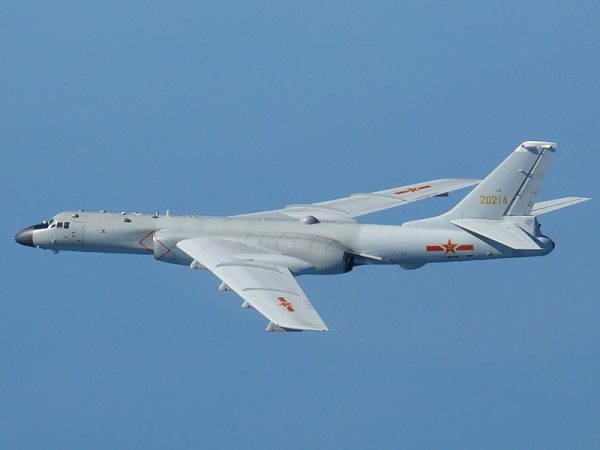The article was first published on Warrior Maven, a Military Content Group member website. China’s known and often documented H-6K bomber“encirclement” patrols around Taiwan are clear efforts to apply added and somewhat expected intensified pressures upon Taiwan, yet they also appear to have involved specific technological upgrades and weapons enhancements integrated into the H6K bomber.
“The H-6K bomber is capable of carrying a wide variety of munitions including the KD-20 land attack missile, the YJ-12 supersonic anti-ship missile and the YJ-21 hypersonic missile,” the Global Times reports.
The YJ-12 is certainly a known weapon as a supersonic cruise missile, as is the KD-20, yet their presence on the H6K may indicate the presence of new kinds of fire-control and weapons guidance technologies intended to improve the strike range and accuracy of the bomber’s stand-off threat to land targets in Taiwan. The most significant part of this June 19, 2023 report in the Global Times, however, is that it claims the H6K is now armed with a YJ-21 “hypersonic missile.” The YJ-21 air-launched hypersonic missile can reportedly reach speeds of Mach 6.
Being armed with or capable of carrying the missile does not necessarily mean the H6K night patrols over Taiwan are now carrying hypersonic missiles, yet the potential existence of an air-launched variant is extremely significant. If true, it potentially places the People’s Liberation Army – Air Force, and Navy ahead of the US services. The Air Force has recently “paused” its hypersonic Air-Launched Rapid Response Weapon, and the Navy does not plan to arm its destroyers with the Conventional Prompt Strike hypersonic weapon until 2025.
Military Watch magazine and Naval News both cite the existence of the YJ-21, yet only terms of a surface-ship-launched application. Both reports cite a People’s Liberation Army – Navy video showing the test-firing of the YJ-21 “hypersonic missile” from its emerging, quasi-stealthy Type 055 Destroyers. However, neither report from 2022 mentions an “air-launched” YJ-12 hypersonic missile variant, so the H6K-launched variant cited in the Chinese paper may be something China has developed quite recently. While Naval News’ essay from 2022 is clear to point out that there is still much “unknown” about the YJ-21, the publication quotes a Naval News analyst H I Sutton as saying the JY-21 is appears to be based upon the CM-401 design.
“The new missile outwardly resembles the CM-401 design, with the addition of a large booster phase. The CM-401 is roughly analogous to the Iskander missile although its diameter is only 600mm. It is possible that the new missile is related to the older CM-401 family, although the resemblance may be coincidental. And it may have a smaller diameter,” Sutton writes in Naval news.
The existence of an air-launched YJ-21 variant raises critical questions about its level of maturity, testing and potential production. Equally important, what kind of range and targeting guidance technology does it use? These are questions likely to inspire attention at the Pentagon.
The article was first published on Warrior Maven, a Military Content Group member website. China’s known and often documented H-6K bomber“encirclement” patrols around Taiwan are clear efforts to apply added and somewhat expected intensified pressures upon Taiwan, yet they also appear to have involved specific technological upgrades and weapons enhancements integrated into the H6K bomber.
“The H-6K bomber is capable of carrying a wide variety of munitions including the KD-20 land attack missile, the YJ-12 supersonic anti-ship missile and the YJ-21 hypersonic missile,” the Global Times reports.
The YJ-12 is certainly a known weapon as a supersonic cruise missile, as is the KD-20, yet their presence on the H6K may indicate the presence of new kinds of fire-control and weapons guidance technologies intended to improve the strike range and accuracy of the bomber’s stand-off threat to land targets in Taiwan. The most significant part of this June 19, 2023 report in the Global Times, however, is that it claims the H6K is now armed with a YJ-21 “hypersonic missile.” The YJ-21 air-launched hypersonic missile can reportedly reach speeds of Mach 6.
Being armed with or capable of carrying the missile does not necessarily mean the H6K night patrols over Taiwan are now carrying hypersonic missiles, yet the potential existence of an air-launched variant is extremely significant. If true, it potentially places the People’s Liberation Army – Air Force, and Navy ahead of the US services. The Air Force has recently “paused” its hypersonic Air-Launched Rapid Response Weapon, and the Navy does not plan to arm its destroyers with the Conventional Prompt Strike hypersonic weapon until 2025.
Military Watch magazine and Naval News both cite the existence of the YJ-21, yet only terms of a surface-ship-launched application. Both reports cite a People’s Liberation Army – Navy video showing the test-firing of the YJ-21 “hypersonic missile” from its emerging, quasi-stealthy Type 055 Destroyers. However, neither report from 2022 mentions an “air-launched” YJ-12 hypersonic missile variant, so the H6K-launched variant cited in the Chinese paper may be something China has developed quite recently. While Naval News’ essay from 2022 is clear to point out that there is still much “unknown” about the YJ-21, the publication quotes a Naval News analyst H I Sutton as saying the JY-21 is appears to be based upon the CM-401 design.
“The new missile outwardly resembles the CM-401 design, with the addition of a large booster phase. The CM-401 is roughly analogous to the Iskander missile although its diameter is only 600mm. It is possible that the new missile is related to the older CM-401 family, although the resemblance may be coincidental. And it may have a smaller diameter,” Sutton writes in Naval news.
The existence of an air-launched YJ-21 variant raises critical questions about its level of maturity, testing and potential production. Equally important, what kind of range and targeting guidance technology does it use? These are questions likely to inspire attention at the Pentagon.
Night-Mission H6K Bomber Encirclement of Taiwan
Possible hypersonic and supersonic air-launched land-attack cruise missiles carried on the H6K present complicated threats to Taiwan, as they could conduct surprise attacks on critical land targets from safer stand-off distances. Closer, Stand-In attack such as air dropped bombs would leave the H6K much more vulnerable to Taiwanese air defenses and also be easily seen by US Navy and Taiwanese surveillance technologies. The continued presence of “encirclement” missions, however, place Chinese bomber within rapid striking range of Taiwan at any time, something the Chinese paper is not hesitant to point out.
Citing “provocations” by what the paper refers to as secessionists, a Chinese military expert was quoted in the Global Times saying that “external interference forces could also take place at night.” As part of this, the paper cites US House Speaker Nancy Pelosi’s visit to Taiwan in August, 2022.
The Global Times essay was also clear that the H6-K night patrols would likely become routine, given that technological advances have enabled the bombers to conduct more precise and successful nighttime missions.
“We have the capability to sortie at any time and anywhere, be it at day, at night, or before dawn,” Wei Xiaogang, an instructor at the air group, said in the CCTV report, as cited in the Global Times.
The suggestion of night-time operations indicates that the People’s Liberation Army – Air Force, may now be operating with enhanced night-vision and navigation technologies. It is not clear what, exactly, this kind of emerging technology may be, however it may be some kind of copycat of “night vision” technologies pioneered by the Pentagon for the F-35 as far back as 2019. F-35 pilots now fly with a “Helmet-Mounted Display,” a visor-projected night vision technology engineered for precision-night targeting, navigation and advanced spatial orientation. US B-52 pilots also wear certain kinds of night vision goggles, technology which has likely improved in recent years. While the B-52 is considerably larger than China’s H6K and capable of carrying a much larger payload, the two rival bombers are similar in speed and the fact that they both first emerged in the 1950s.
Also, the suggestion of “all-weather” in the Chinese paper regarding the H6K bomber suggests that the aircraft may now be integrated with new kinds of “sensing” technology. Millimeter wave technology, for example, is a highly effective all weather sensor used for navigation and weapons guidance by US Air Force platforms. This is another technology which Chinese weapons developers may have tried to copy. However, the suggestion of all weather sensing in the Chinese paper may simply be referring to Synthetic Aperture Radar and InfraRed sensing, both of which can function at night.
The largest difference with night navigation technology, should there be enhancements to the H6K, is likely along the lines of night pilot viewing, targeting and navigation similar to innovations engineered for the F-35.
Technological upgrades and an expanded mission envelope such as what these might suggest pertain to broader and quite impactful concerns regarding A2/AD and China’s rapid modernization.
The PLA Air Force is expanding and continuing to upgrade its fleet of bombers, an observation made in the Pentagon’s 2021 annual China Report.
“The PRC’s bomber force is currently composed of H-6 Badger variants, which are domestically produced versions of the Soviet Tupolev Tu-16 (Badger) bomber. Despite the relative age of its bomber force, the PLAAF has worked to maintain and enhance the operational effectiveness of these aircraft. In recent years, the PRC has fielded greater numbers of the H-6K, a modernized H-6 variant that integrates standoff weapons and features more-efficient turbofan engines for extended-range,” Office of the Secretary of Defense’s Annual Report to Congress: Military and Security Developments Involving the People’s Republic of China 2021
Mission expansion for China’s H6K bomber fleet would align with the Pentagon’s assessment of the Chinese bomber printed in the Pentagon’s annual China report in 2021, as cited in an Air University essay called “PLA Air Force, Bomber Force Organization,” by Ken Allen, Former Air Force Officer & Assistant Air Attache, US Embassy Beijing & Warrior Maven Senior Long-Term China Military Analyst.
“During the PRC’s 70th anniversary parade in 2019, the PLAAF publicly revealed the H-6N, a derivative of the H-6K optimized for long-range strikes. The H-6N features a modified fuselage that allows it to carry externally an air-launched ballistic missile (ALBM) that may be nuclear capable. In October 2020, an H-6N was observed carrying an air-launched ballistic missile,” Allen writes.
An uptick in H6K fleet size, the addition of an H-6N and the H6K’s expanding mission scope would certainly enhance the air threats presented by China, as the H6K’s weapons capability is reported by the Pentagon to be both extensive and extremely dangerous.
The H-6K can carry six land-attack cruise missiles (LACMs), giving the PLA a long-range standoff precision strike capability that can range targets in the Second Island Chain from home airfields in mainland China.“ Office of the Secretary of Defense’s Annual Report to Congress: Military and Security Developments Involving the People’s Republic of China 2021:
An interesting 2011 Naval War College Review essay on Chinese military thinking and progress titled “From Bottle Rockets to Lightning Bolts…China’s Missile Revolution and PLA Strategy against U.S. Military Intervention, ”takes up a relevant discussion of China’s air-launched Land Attack Cruise Missiles in the context of China’s often discussed anti-access/area-denial strategy. The well known A2/AD strategy, intended to prevent US forces from operating within effective striking distance, continues to evolve in alignment with rapid Chinese military modernization in a way the essay seems to anticipate. While being from 2011, the essay does not mention the possibly “hypersonic” YJ-21 cited in the Global Times, it does say the YJ-12 supersonic cruise missile can hit ranges of 400km, ranges which certainly would place areas of Taiwan and US Navy surface warships at risk, depending upon its guidance, precision targeting technology.
The 2011 essay cites “missiles” as being among a series of emerging Chinese weapons intended to “deter,” “slow down,” “disrupt” and “complicate” deployment of American assets to the theater of operation, rather than engage them directly.
More specifically, the Naval War College Review seems to anticipate what it refers to as growing “synergies” between China’s missile and air forces, precisely the kind of weapons-integration now seen on the H6K. This is also something, as suggested by the essay, that China has been trying to synchronize with its growing Navy. The addition of an air-launched, hypersonic YJ-21 certainly adds to and complicates the threat equation for US Naval assets seeking to counter China’s A2/AD strategy.
“The critical aspects of a new Navy and the synergies that may develop between it and the missile and air forces warrant full attention, because they are directed specifically at deterring, delaying, or complicating timely and effective U.S. access and intervention,” the Naval War College essay cites, referring to an often-quoted retired US Navy Admiral.
Perhaps the most significant point of analysis from the Naval War College essay pertains to timing, as the essay was written in 2011. What was, at that time, an “indirect” strategy to keep US forces away without directly “engaging” them, may have evolved into more modern Chinese estimations of its growing Naval and Air power. Perhaps now more than ever, and certainly in coming years, the PRC feels it may actually be positioned to “engage” US forces, unlike what may have been the case in 2011.
What this suggests is that perhaps the PRC will see a “window” of opportunity through which to seize and annex Taiwan earlier than current Pentagon projections, which estimate China’s intention to control Taiwan by 2027. Could technological advances and a massive increase in Naval power, drones and air-attack cruise missiles, lead Chinese decision-makers to think it might be able to hold US forces “far enough away” to succeed in a “Fait Accompli,” meaning a rapid annexation of Taiwan taking place too fast for the US to respond. A large part of this “Fait Accompli” prospect, which is specifically cited in numerous Pentagon reports on China, would also be to simply make it far too costly in lives for any kind of US coalition to attack and “extricate” a Chinese force firmly embedded in Taiwan. Perhaps with hypersonic missiles fired from the air in close proximity to Taiwan during night “encirclement” missions might offer China the possibility of a fast-attack attempt to take over Taiwan before a response or counterattack is possible.



